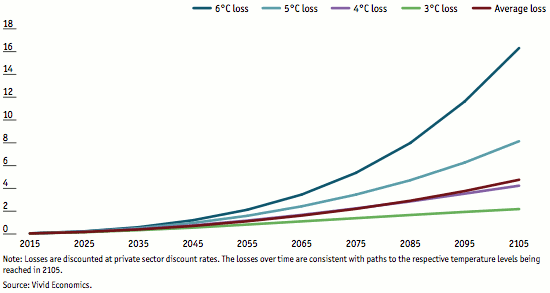The potential financial impact from climate change to the asset management and wider investor landscape is far higher than previously believed, according to a report, highlighting a potential opportunity for the reinsurance and insurance-linked securities (ILS) sector.
The report, conducted by The Economist’s Intelligence Unit, seeks to quantify the potential losses faced by asset managers and institutional investors globally, via direct (floods, droughts, hurricanes, etc.) and non-direct (weaker growth and lower asset returns) implications of climate change.
According to data from the Financial Stability Board, the current global stock of manageable assets is an estimated $143 trillion (the report explains that this is the stock of assets held by non-bank financial institutions).
And analysis from The Economist Intelligence Unit estimates that by the year 2100 the global value at risk (which measures the size of the loss a portfolio may experience, within a given time horizon, at a particular probability) as a result of climate change to the global stock of manageable assets is $4.2 trillion, in present value terms.
The study continues to predict that an overall warming of 5°C by 2100 could result in losses of $7.2 trillion, “more than the total market capitalisation of the London Stock Exchange,” and a 6°C warming could result in losses nearing $13.8 trillion, “roughly 10% of the global total.”

Present value loss to current manageable assets (trillion $, 2015 prices)
It’s important to note here that these figures represent the perspective of private and institutional investors, as when considering governments the numbers rise dramatically, as follows.
The value at risk from the perspective of a government is a staggering $13.9 trillion, notes the report. While warming of 5°C by 2100 could lead to $18.4 trillion in losses, and warming of 6°C could result in a $43 trillion loss.
The Economist says; “These figures represent the harm to financial assets from the impacts of climate change if warming is not significantly mitigated.”
The threat that a warming climate poses to coastal communities due to sea level rises, to agriculture due to desertification and to other industries is understood. The threat from more severe weather and catastrophes is less certain, but still widely discussed in scientific circles.
As a result the outlook for insurance, reinsurance and as a result the ILS and catastrophe bond market is one of rising exposures, at least in terms of values at risk, which should require new capacity and increase the demand for weather and natural disaster risk transfer.
Therefore insurers, reinsurers and the ILS market have a role to play in making available the products and capacity required to help to offset the growing exposure, providing a significant opportunity to the market in terms of new capacity likely to be required.
The report continues to stress that the “insurance sector is particularly exposed as greater outlays will likely be required to cover natural disasters, while at the same time the overall portfolios which must fund their liabilities will be diminished.”
So for insurers and reinsurers there is also a threat to their asset portfolios, making the deployment of capacity to transfer weather and climate risks, which will help to finance resilience, actually beneficial to their own prospects as well.
The impact of climate change resulting in the increased severity and frequency of natural disasters is a long-running debate across the risk transfer markets, and wider disaster resilience discussions.
However, while opinions on the severity and even actuality of climate change still vary, the estimated $4.2 trillion value at risk total for private investors, combined with the significantly higher $13.9 trillion of potential losses for public sector entities, is essentially a possible future protection gap.
And one that can be mitigated and limited through the use of established, or new, innovative risk transfer solutions and structures offered in the insurance, reinsurance, insurance-linked securities (ILS) and catastrophe bond space.
Regardless of climate change, increased urbanisation to coastal and hazard prone areas and a rise in global asset values has brought the importance and necessity of effective risk transfer solutions to the forefront of world disaster resilience efforts in recent months.
And The EIU’s report again highlights just how significant the capacity, expertise, knowledge and understanding of risks that makes up the international insurance, reinsurance and ILS market is in mitigating potential future losses, to both public and private sector entities.
If the world’s assets and investors are so exposed to the risk of changing climate and resulting sea level rises and fluctuating weather patterns, then so too are the world’s corporations. Protecting globally active corporations against the threat of climate impacts, by providing risk transfer products linked to actual weather and loss metrics (think parametric and industry or economic loss triggers), is perhaps the biggest opportunity for providers of reinsurance capital in the future.
The reinsurance and ILS industry has an opportunity to be at the forefront of innovation and the development of efficient, affordable risk transfer solutions for people, businesses and institutions in all corners of the world.
Clearly, the ultimate goal is for all institutions, from both the public and private sector, to seriously increase their mitigation efforts against the potential losses that could arise from climate change.
But this certainly won’t be an easy task, and it’s likely that the insurance, reinsurance and ILS market participants can play a greater role in providing the risk transfer needed to bring the required changes and resilience to fruition, as they have the skills, knowledge, and capital to do so.
 View all of our Artemis Live video interviews and subscribe to our podcast.
View all of our Artemis Live video interviews and subscribe to our podcast.
All of our Artemis Live insurance-linked securities (ILS), catastrophe bonds and reinsurance video content and video interviews can be accessed online.
Our Artemis Live podcast can be subscribed to using the typical podcast services providers, including Apple, Google, Spotify and more.































